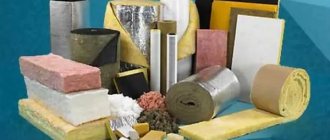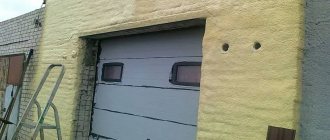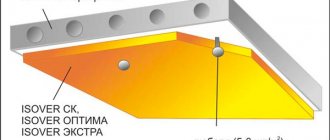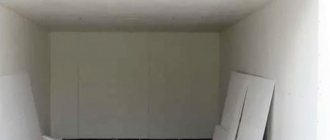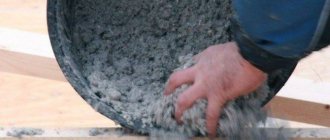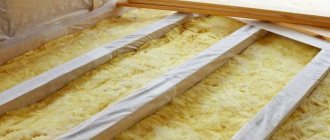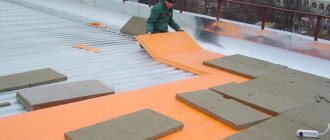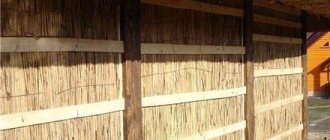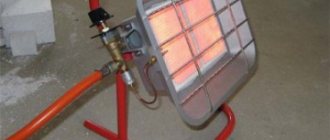Features of ceiling insulation in a garage
The issue of insulation is especially relevant for garages, given that they are mostly made of metal or have concrete surfaces. And in the absence of thermal insulation under conditions of a serious temperature difference (between the room and the street), the objects and cars inside begin to deteriorate, become damp, and rust. It is the accumulated condensation and high humidity that become the main cause of such negative consequences.
To avoid them, it is necessary to provide high-quality ventilation and maintain an optimal temperature inside the garage for winter - up to +5 ° C. Particular attention should be paid to insulating the ceiling, since most of the heat escapes through it. In addition, if you insulate everything correctly, you will be able to save on heating costs.
Why insulate the ceiling in a garage?
We are, of course, not talking about metal garages, but about permanent buildings located near the place of residence. Often such buildings have a concrete ceiling, which has the ability to absorb significant amounts of moisture. For a car, high humidity from the inside is the worst enemy, as it provokes corrosion of metal parts. In addition to the humidity indicator, temperature values are also important. In winter, a garage without insulation will not be warm at all. Accordingly, if you place a car in it that is hot while driving, condensation may form inside as it cools. This will have a detrimental effect on both the condition of the body and the condition of the electrical system and all internal equipment.
The issue of insulation is especially acute for those drivers who prefer to leave their car in the garage for several cold months. Even one winter season of parking in a garage without special preparation can significantly worsen the condition of the “iron horse”. It is also important to take into account the fact that the roof of concrete garages is often replete with cracks. During the autumn and winter seasons, the car will be constantly exposed to drops of water. To summarize the above, it is easy to understand that insulating the garage roof is by no means unnecessary. The work is quite easy to do yourself, especially if it is carried out from the inside of the room.
How to insulate a garage ceiling from the inside
Thermal insulation of the ceiling in the garage must be done using reliable and durable material. Mineral wool is suitable for these purposes. This heat insulator, unlike others, is attractive due to its accessibility.
Among the advantages it is worth noting:
- sufficient heat-saving characteristics;
- fire safety;
- vapor permeability;
- maintaining shape during long-term use;
- versatility of use (both outside and inside the room).
The disadvantages include:
- fear of material with high humidity;
- work only in special clothing using protective equipment.
You can buy mineral wool either in a roll or in the form of sheets.
It is also good to use foam blocks to insulate the room. The strengths of foamed plastic mass include:
- low degree of heat conduction;
- light weight;
- good resistance to humid environments.
In addition, due to its rigid shape, the insulation does not cause difficulties during processing and installation. The service life is 30-50 years (depending on the conditions of use), rodents and insects do not like it.
When burning, polystyrene foam releases toxic substances that are harmful to human health.
Penoplex is one of the improved types of heat insulator. It is chosen by:
- for a smaller thickness against the background of high thermal insulation qualities;
- ease of installation;
- durability;
- resistance to moisture and fire.
Due to the special protrusion, the joining of two sheets occurs easily and reliably, no cracks or gaps are observed.
A tight joint guarantees the tightness of foam sheets
Polyurethane foam is an insulation material that is produced in liquid form and applied to the surface by spraying. After drying, the insulation layer is sealed and resistant to high humidity and rotting.
Polyurethane foam does not cause problems when processing complex surfaces (with obvious irregularities). The use of adhesive insulators, if you need to insulate a room, will be appropriate on concrete ceilings.
Disadvantages include the high cost of polyurethane foam and the need for special equipment. Important! If the garage has a metal roof, then it is more effective to choose materials for insulation that do not come into contact with the surface being treated.
How to make a ceiling fireproof?
You can use expanded polystyrene (penoplex) instead of polystyrene foam. It is impregnated with some kind of fire-fighting compound and goes out on its own. I tried to set fire to this one. Indeed, it burns worse than polystyrene foam, but it also burns out quite well before going out. In my opinion, in a severe fire there is little difference between the two.
I decided for myself that it would be better to cover the foam with plaster, as time and desire allow. And the appearance of the ceiling will improve, and there will be no protection from fire.
How to prepare a garage ceiling for insulation
Before insulating the ceiling surface, you need to prepare it so that the quality of the heat insulator does not deteriorate in the future. First of all, you should remove the old finish and clean it from dirt. If fungus is detected, the ceiling is treated with bleaching agents and antiseptic compounds. For ease of use, you should give preference to a quick-drying primer.
To insulate the ceiling in a concrete garage, you need to prepare the following materials and tools:
- roulette;
- marker/pencil;
- fasteners (dowels, nails);
- electric drill;
- hammer;
- insulation (foam plastic, mineral wool);
- polyurethane foam/silicone sealant.
Instructions and stages of work
It is necessary to insulate the ceiling in the garage in compliance with all technological stages and using the necessary tools.
Materials and tools
Basic materials and tools that will be needed for installing thermal insulation:
- selected insulation;
- vapor-permeable membrane for waterproofing;
- dense polyethylene;
- cement mortar;
- polyurethane foam;
- mesh for reinforcement;
- roofing felt or bitumen mastic;
- wooden block;
- galvanized profile;
- antiseptic impregnation;
- glue;
- fasteners, tape;
- tools - jigsaw, drill - screwdriver, spatula, construction knife, stapler.
A jigsaw is used to cut bars, metal profiles, lining and other external finishing materials. A drill will be required to attach the layers of thermal insulation. Use a spatula to clean the surface during preparatory work. The insulation is cut with a construction knife, and the vapor barrier is attached with a stapler.
To finish the inside you will need plasterboard, plastic panels or other suitable materials.
Preparatory work
Preparation from the inside requires thorough cleaning of the surface from paint, lime, and dirt. Outside - on the roof or attic you need to remove old coverings and debris. Existing cracks are carefully sealed with cement mortar. Thermal insulation work outside is carried out in dry and warm weather.
Insulating the ceiling from the outside
The roof or floor in the attic is insulated from the outside. Thermal insulation work on the attic floor can be carried out in a simple or more complex way. When choosing the first method, insulation is glued to the floor, which is covered with plywood or chipboard on top.
Insulating the ceiling from the outside
The sequence of work with thorough insulation is as follows:
- A layer of sand no more than 10 cm thick is poured onto the floor of the attic.
- Thick polyethylene or geotextile is laid on top, which will serve as waterproofing.
- Filling is done with expanded clay and a reinforcing mesh is laid.
- A layer of concrete mortar is poured and left until completely fixed.
Finishing does not need to be done.
You can choose another method of attic insulation:
- The sheathing is made from timber with a cross-section of 40x40 mm.
- Mineral wool or polystyrene foam is placed in the formed cells.
- A vapor barrier (for example, plastic film) is stapled on top.
- The final layer is laid with boards, chipboard or plywood.
Wood materials need to be sanded and painted.
Insulating the roof involves laying roofing felt and penofol on top of it. The final finishing can be slate, metal profiles, or roll roofing.
How to properly insulate a garage ceiling
To obtain the most positive result, you need to adhere to a certain algorithm of actions for laying insulation. When using wooden blocks to make a frame, preference should be given to dry wood without signs of damage by insects or pathogenic microorganisms. Before insulating the room, the building material is treated with an antiseptic.
How to insulate a garage ceiling from the inside with polystyrene foam
The process of thermal insulation of a garage roof from the inside consists of the following steps:
- Manufacturing of sheathing. It can be either made of wooden blocks treated with a deep penetration antiseptic, or made of metal profiles. It is good to fasten them using a hammer drill and dowels. The distance between the bars must correspond to the size of the foam. The insulation sheets must fit tightly between the joists.
- Applying glue to the ceiling and installing insulation. The heat insulator is applied to the surface to be treated and pressed. The fixation of the sheets is also supplemented with plastic dowel mushrooms, which are mounted in holes pre-made with a puncher. In order to properly insulate the room, for greater tightness, all areas of the connection must be filled with foam
- Finishing with facing material. For example, plastic panels, moisture-resistant plasterboard with subsequent painting. Plastic panels are resistant to temperature changes
You can use foam sheets for insulation without installing sheathing. The material is glued to a previously prepared surface and fixed with plastic mushrooms. Polystyrene foam is great when you need to insulate the ceiling of a cellar in a garage.
How to insulate a garage ceiling with penoplex
The active use of penoplex is explained by its ease of installation and good thermal insulation qualities. The step-by-step process is as follows:
- Clean and treat the metal surface with an anti-corrosion compound, preferably in several layers.
- Mark the ceiling according to the dimensions of the insulation. Apply glue (polyurethane) to the foam sheets using a serrated tool and press it to the surface to be treated. When insulating, it is better to place the slabs from the corner, but you can also start from the center. Adjacent sheets should be glued close to each other
- Treat joints with construction foam. Thanks to this simple technique, it will be possible to eliminate the appearance of cold bridges, therefore, the degree of surface tightness increases significantly.
- After final drying, excess foam is removed with a stationery knife, and these places are glued with reinforced tape. Insulating a garage will be much more effective this way. Polyurethane foam is easy to process
- The insulated ceiling is plastered and painted.
How to insulate a garage ceiling with mineral wool
It is not difficult to insulate a wooden or any other ceiling in a garage using mineral wool. The main thing is to follow the following sequence of actions:
- Prepare the surface. The ceiling is cleaned of the old finish, all cracks are puttied and a deep penetration agent is applied. If the ceiling is wooden and it is necessary to insulate it, then sew on sheet material such as OSB boards. The primed surface is reliably protected from mold
- Place foil-isolon on the treated and dried ceiling surface. It must be glued in strips without overlapping, otherwise condensation will accumulate in these areas.
- Reinforced self-adhesive tape is perfect for sealing the seam. In addition to glue, you can use double-sided tape to secure the insulator. Installation of the sheathing is done using dowels and screws
- Arrange the frame on the ceiling on top of the foil-isolon. Using a level and a tapping cord, you need to mark lines on the walls for the lower guides. When they are secured, longitudinal and transverse profiles are mounted on the hangers. The distance between the slats must correspond to the size of the insulation sheets. Docking points are taped
- Laying insulation and a second layer of foil material. The insulation is fixed with double-sided tape or with a construction stapler if the frame is wooden.
- Making a second sheathing over foil-isolon. Here, slats 2 cm thick are used. This will create a ventilation gap between the finishing and the insulation.
How to insulate a garage ceiling with polyurethane foam
You can insulate your garage from the inside at any time of the year. When using polyurethane foam, the room must be completely emptied; there should be no car in it, no tools or things on the shelves, no boxes or other storage devices on the floor.
First of all, when insulating, the ceiling surface is cleaned of old flaking coating, lime, whitewash, paint. When all preparation work is completed and the ceiling is dry from water, begin spraying polyurethane foam.
Polyurethane foam is one of the best insulation materials for garages, durable and with high heat-saving qualities.
The advantage is that there is no need to plaster or prime the surface or treat it with water-repellent compounds.
Important! The material has a high degree of resistance to moisture.
When applying a liquid heat insulator, there is no need to equip a lattice structure. It is sprayed onto the surface to be treated in a layer of 5-8 cm. This modern material is rightfully one of the best insulation materials for garage ceilings. It has high technical and operational characteristics. Despite the high cost of this method, the heat insulator will last 50 years. In this way, you can insulate the garage ceiling under the room - it is both effective and long-lasting.
Materials for thermal insulation
There is a fairly wide selection of materials that effectively retain thermal energy. They have different properties, have individual shapes and features, so you should consider them separately:
Mineral wool
The term refers to a group of materials produced from the melt of various minerals. The familiar slag wool and glass wool also belong to this group, although they are usually called by their proper names. In a narrower sense, mineral wool is a heat insulator made from the melt of certain types of rocks of volcanic origin. Monofilament is pulled from it, which is then turned into mats or slabs of varying degrees of density and rigidity. Mineral wool has significant advantages:
- High heat-saving qualities;
- Absence of elements that irritate the organs of vision or breathing;
- Vapor permeability, allowing the material to be used for both internal and external insulation;
- Fire safety;
- Mold and mildew do not appear, insects or rodents do not infest;
- There is no change in shape or volume with prolonged use;
- The durability of the material is about 70 years;
- The material is produced in various forms, allowing you to choose the best option for insulating planes, curved surfaces, pipelines, etc.
Mineral wool is an inexpensive and easy-to-use material for insulation
The disadvantage of mineral wool is its ability to absorb moisture. Wet insulation loses its working qualities, so during installation it must be protected with a layer of waterproofing film. This property somewhat reduces the popularity of the material, but high vapor permeability - a rare property among thermal insulators - increases the demand for mineral wool among users.
Styrofoam
Granulated polystyrene foam is the real name of this material. It is made from gas-filled sealed polystyrene foam granules, which are sintered in special installations under the influence of superheated steam. As a result, large arrays of insulator are obtained, which are then cut into even slabs of a given thickness.
Polystyrene foam has many advantages:
- Low thermal conductivity;
- Light weight;
- Rigid and durable shape;
- Ease of installation and processing;
- Durability;
- Resistant to moisture;
- The material does not support combustion.
Foam boards are convenient to install on ceiling surfaces
There is constant debate about the fire safety of polystyrene foam. Some claim that it does not burn, and show videos confirming this point of view. Others provide statistical data, real cases of fires and fires involving polystyrene foam. The essence of the matter is that the granules inside consist of a large number of carbon dioxide microbubbles. If you try to set fire to a piece of material, you will notice that it does not support combustion, since the carbon dioxide released extinguishes the fire.
It is important! But if the material enters a zone of strong heating and melts, all the gas evaporates, and the puddle of polystyrene begins to burn quite actively. Therefore, the fire safety of polystyrene foam is somewhat conditional in nature, which must be taken into account when choosing a material.
Despite everything, polystyrene foam occupies a leading position among all types of insulation due to its low price. The opportunity to save money attracts most users, and the other qualities of the material are practically in no way inferior to alternative options.
Penoplex
Penoplex is extruded polystyrene foam. From a chemical point of view, it is the closest relative of polystyrene foam, but physically it has noticeable differences. In the manufacture of penoplex, a different technological process is used, the result of which is solid slabs of foamed polystyrene, absolutely impermeable to water, having greater rigidity and density. In all performance characteristics, the material, although slightly, is superior to foam. The absence of granules eliminates the ability to crumble, which is observed in low-quality foam.
It is important! The slabs have a very clear geometry and calibrated thickness. Some of them have a special protrusion, which allows making a tighter joint during assembly, which increases the tightness of the insulation material.
Solid foam boards are a popular insulation material.
The main disadvantage of penoplex is its higher price, but recently there has been a noticeable trend towards a decrease in its cost, which immediately affected demand. A noticeable advantage is the wide variety of types of penoplex designed to work in different conditions, which allows you to choose the type of insulator that is most suitable for given conditions.
Liquid polyurethane foam
A specific type of insulation that is produced in the form of a liquid. It is sprayed onto the surface to be treated, and in the air the liquid foams and hardens, forming a layer of insulation. Outwardly, it looks like polyurethane foam. The insulation fabric is completely sealed, completely impervious to water, and has low thermal conductivity. The method of application makes the material very convenient when it is necessary to insulate complex surfaces that have many small elements, curved or uneven areas, where dense installation of rigid types of insulation is impossible.
It is important! The disadvantages of the material are the relatively high price and the need to use specialized equipment. These two factors limit the popularity of liquid polyurethane foam, although for many cases it is the optimal choice.
Liquid polyurethane foam has ideal heat-saving properties, but is expensive and requires special equipment
Foam glass
This insulation has been known for a long time, but it appeared on the market relatively recently, so users are still just taking a closer look at it. Externally, it looks like solid foam and has all the qualities and properties necessary for a heat insulator. Moreover, foam glass is not subject to aging, does not react to moisture or temperature changes, and is not afraid of contact with chemicals.
The material is available in different forms:
- Bulk forms - granules, gravel, sand, crushed stone;
- Blocks;
- Plates;
- Shells (special shaped products for installation on pipes).
Foam glass is a durable material for thermal insulation
The durability of foam glass, which has now been confirmed in practice, is at least 50 years (observations were made on objects insulated with the first experimental samples of the material, since then its quality has radically changed for the better). The disadvantages of the material are high cost and heavy weight. If the price issue usually disappears over time as production develops and demand emerges, then weight is a significant disadvantage. Excessive load on supporting structures is harmful and even dangerous, so foam glass should be used only after appropriate calculations.
Penofol
Penofol is a modern insulation material produced in rolls. It consists of polyethylene foam and is completely impermeable to water. The material is quite thin, about 1 cm, but modern technologies make it possible to get a greater effect from its use than from several layers of other types of insulation. There are three types of penofol:
- Penofol A. Has a layer of foil on one side that reflects infrared rays back into the room. The second side is free and is used for applying adhesive or for tightly attaching to the surface.
- B. Both sides of the material have a foil layer, which avoids installation errors and provides some advantages in terms of heat conservation.
- C. One side has a layer of foil, and the other has a sticky layer. This material is convenient for installation in difficult conditions.
Installation of penofol is convenient due to the small thickness of the material. It is lightweight, flexible, and can be installed on any surface.
Penofol - modern thin roll insulation
For garages with metal roofs, it is recommended to use materials that do not have close contact with the insulated surface. The adhesive layer reacts poorly to thermal expansion of the supporting plane, causing the insulator to peel off and cease to perform its functions. Materials such as liquid polyurethane foam, penofol or other lining materials are best used on concrete floors. For metal ceilings, it is necessary to leave an air gap between the metal and the insulator, which increases the efficiency of insulation and eliminates the possibility of deformation of the material.
Advice from professionals
To avoid mistakes when carrying out thermal insulation work in the garage, you need to take into account the recommendations of specialists:
- If there is poor ventilation in the room, the level of humidity in it will be quite high, which will lead to damage to property.
- When insulating, lighting must be removed in advance, stretching it over the last layer of heat insulation.
- The arrangement of a lattice structure allows you to expand the possibilities in matters of final finishing: installation of plasterboard sheets, plastic panels, OSB boards, plywood.
How to insulate a roof from the outside or inside
The choice of thermal insulation method for a garage roof - from the inside or from the street - depends on the roof design and the material used. Each thermal insulation material is unique in its own way, which allows the use of various technologies for roof thermal insulation
You should not choose polymeric and flammable materials; it is better to pay attention to fiberglass or basalt wool
To insulate the garage roof from the inside, you will need preliminary installation of sheathing on the ceiling, laying thermal insulation in the frame, laying a vapor barrier to protect the insulation from moisture, and finishing the ceiling. To insulate the garage roof from the outside, you will need a moisture-resistant material (extruded polystyrene foam or Tekhnoruf). External insulation will protect the concrete roof from freezing.
Insulation of the ceiling from above from the attic side
Between the joists or beams you need to put waterproofing.
After this - polystyrene foam, laid very tightly, without gaps. Then again a layer of insulation. After this you can make the floors.
There are two ways to fasten foam plastic indoors. With the first, a frame is first made from wooden beams or a metal profile.
Sheets of insulation are cut out in accordance with the cells of the frame and secured with dowels or glue. In the second, more economical method, sheets of foam plastic are immediately attached to the ceiling using special glue. In this case, the ceiling must first be prepared.
Advantages:
- Low thermal conductivity.
- Low hygroscopicity, which allows you to avoid vapor and waterproofing when installing.
- Retains its characteristics throughout the entire period of operation.
- Has good sound-absorbing properties.
Easy to install, light weight, cuts well.
Flaws:
- Short service life 5-10 years.
- Cannot be used in homes with poor ventilation. The material is vapor-proof; moisture causes mold and mildew to appear in the room.
- When burned, it releases harmful substances that are hazardous to health.
- Reduces the height of the room by 5-6 cm.
Polymer materials
Polystyrene foam is resistant to moisture. When assessing the cost of other materials, it is worth noting its cheapness. Its serious drawback is that it is a fire hazard. Sometimes mice chew through the material. Typically, insulating any ceiling in a garage with foam plastic is not difficult.
Polystyrene foam as insulation for garage ceilings
Penoplex is similar to polystyrene foam, but is manufactured using an improved system. The sheets are rectangular with a chamfer along the edge. Docking and laying is as easy as foam. The insulation method differs by attaching one piece of penoplex to another. Sheets come in different thicknesses from 1 to 10 cm.
Penoplex
Fiberglass
Broken glass is the basis of the composition of the material. One of the important advantages is accessibility. The material is capricious regarding water and humidity in the room. It has a detrimental effect on the fibers, gradually destroying their structure. Easily catches fire.
The material is not easy to handle. Requires a waterproofing layer and, if possible, the installation of a fire barrier. Installation requires certain protection - preventing glass wool dust from entering the respiratory tract and eyes.
Glass wool
Modern materials - penoizol, polyurethane foam and liquid insulation
New materials have already managed to establish themselves in the construction services market. They represent spraying a foam composition onto an indoor surface. Their popularity is due to a number of advantages among classic materials for thermal insulation:
- no deformation;
- long service life - up to 40 years;
- versatility - suitable for both ceilings and walls;
- resistance to moisture, preventing the development of an unfavorable microenvironment;
- porosity allows you to “breathe”.
You shouldn’t even think about how you can insulate the ceiling in a garage with foam. Do-it-yourself and inexpensively - this expression does not apply to these materials. Each material option requires special application skills. The mixture is in special cylinders. Specialists in this field will best handle the task. They will do everything correctly and according to technology.
Polyurethane foam
